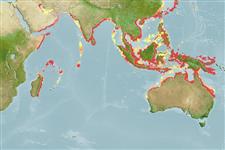>
Carangaria/misc (Various families in series Carangaria) >
Polynemidae (Threadfins)
Etymology: Eleutheronema: Greek, eleutheros = free + Greek, nema = filament (Ref. 45335).
More on author: Shaw.
Environment: milieu / climate zone / depth range / distribution range
Sinh thái học
Biển; Nước ngọt; Thuộc về nước lợ; sống cả ở nước ngọt và nuớc mặn (Ref. 51243); Mức độ sâu 0 - 23 m (Ref. 6390). Tropical; 32°N - 26°S, 47°E - 154°E (Ref. 57343)
Indo-Pacific: Persian/Arabian Gulf, Pakistan, India and Sri Lanka (except the Red Sea and East Africa) to northern Australia and New Guinea. Replaced by Eleutheronema rhadinum (Jordan & Evermann, 1902), in East Asia (Japan, China, Viet Nam) (Ref. 41639).
Length at first maturity / Bộ gần gũi / Khối lượng (Trọng lượng) / Age
Maturity: Lm ?, range 29 - ? cm
Max length : 200 cm TL con đực/không giới tính; (Ref. 3479); common length : 50.0 cm TL con đực/không giới tính; (Ref. 3479); Khối lượng cực đại được công bố: 145.0 kg (Ref. 4965)
Các tia vây lưng cứng (tổng cộng): 9; Các vây lưng mềm (tổng cộng): 13-15; Tia cứng vây hậu môn 3; Tia mềm vây hậu môn: 14 - 16; Động vật có xương sống: 25. This species is distinguished with the following characters: second dorsal fin soft rays 14 (rarely 13 or 15) pectoral fin rays 16-18 (mode 17, rarely 15 or 19), pectoral filaments 4; pored
lateral line scales 71-80 (mode 73); scale rows above lateral line 9-12, below 13-15 (14); vomer with deciduous tooth plates on both sides, except in juveniles (< ca. 7.0 cm SL); posterior part of maxilla deep, 3-4% of SL; short tooth plate extension onto lateral surface of lower jaw, 7-9% SL. Colour of upper sides of head and trunk with slight darkish silver tinge, becoming lighter in lower sides; anterior margins of first and second dorsal fins blackish, remaining parts translucent and slightly blackish, respectively; pectoral fin membranes vivid yellow in life, except in large specimens > ca 35 cm SL which is dusky yellow; pectoral filaments white; anterior margin of pelvic fin yellow and other parts white; base of caudal fin yellowish, other parts blackish (Ref. 41639, 57343).
Adults occur mainly over shallow muddy bottoms in coastal waters. Also enter rivers (Ref. 3479, 6390, 11230). Juveniles found in estuaries. During winter, adults ascend the rivers. They usually form loose schools, although larger fish are more often observed in pairs or singly (Ref. 6390). Feed on prawns and fish (largely members of Mugilidae, Engraulidae, and Sciaenidae) with occasional polychaetes. Frequency of crustaceans to fish in the diet varies seasonally. Larvae (7-30 mm TL) feed mainly on copepods and mysids but also take shrimps and prawn larvae (Ref. 57343). Juveniles (31-60 TL) feed on prawns shrimps and mysids (Ref. 57343). Protandrous hermaphrodites. Marketed fresh, frozen, and dried or salted.
In Australia, fish are males at 24-47 cm FL, hermaphrodites at 25-46 cm FL and females at 28-72 cm FL. On the northeast Queensland coast, most blue threadfin are females by 45-50 cm FL. Hermaphroditic blue threadfin develop fom 1-2-year-old fish, and females first appear as 2-3-year-old individuals (Ref. 28736). Male fish probably commence sex reversal immediately after spawning (ie about April-May) and this condition may persist until after the next spawning period (Ref. 28736). The progression from hermaphrodites to females is complete by the following season.
There is little information on the larvae, although nursery areas are known to be lower estuaries, tidal swamps and lagoons, and shallows along the foreshores (Williams 1997).
Motomura, H., Y. Iwatsuki, S. Kimura and T. Yoshino, 2002. Revision of the Indo-West Pacific polynemid fish genus Eleutheronema (Teleostei: Perciformes). Ichthyol. Res. 49(1):47-61. (Ref. 41639)
IUCN Red List Status (Ref. 130435)
Threat to humans
Harmless
Human uses
Các nghề cá: tính thương mại cao; Nuôi trồng thủy sản: Tính thương mại
Các công cụ
Special reports
Download XML
Các nguồn internet
Estimates based on models
Preferred temperature (Ref.
123201): 25.2 - 29.3, mean 28.6 °C (based on 2815 cells).
Phylogenetic diversity index (Ref.
82804): PD
50 = 0.6250 [Uniqueness, from 0.5 = low to 2.0 = high].
Bayesian length-weight: a=0.00617 (0.00400 - 0.00951), b=3.06 (2.93 - 3.19), in cm total length, based on LWR estimates for this species & (Sub)family-body (Ref.
93245).
Mức dinh dưỡng (Ref.
69278): 4.1 ±0.5 se; based on diet studies.
Thích nghi nhanh (Ref.
120179): Trung bình, thời gian nhân đôi của chủng quần tối thiểu là 1.4 - 4.4 năm (Fec=680,000; assuming tm>=2).
Prior r = 0.56, 95% CL = 0.37 - 0.84, Based on 2 stock assessments.
Fishing Vulnerability (Ref.
59153): Very high vulnerability (90 of 100).
Climate Vulnerability (Ref.
125649): Very high vulnerability (91 of 100).
Nutrients (Ref.
124155): Calcium = 38.1 [12.5, 117.4] mg/100g; Iron = 0.744 [0.292, 1.866] mg/100g; Protein = 20 [18, 22] %; Omega3 = 0.122 [0.065, 0.224] g/100g; Selenium = 52.9 [18.1, 162.0] μg/100g; VitaminA = 15.1 [5.7, 40.9] μg/100g; Zinc = 0.92 [0.46, 1.74] mg/100g (wet weight); based on
nutrient studies.
